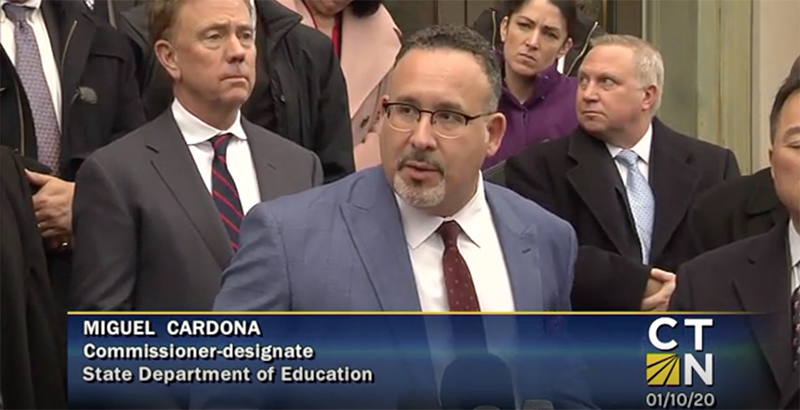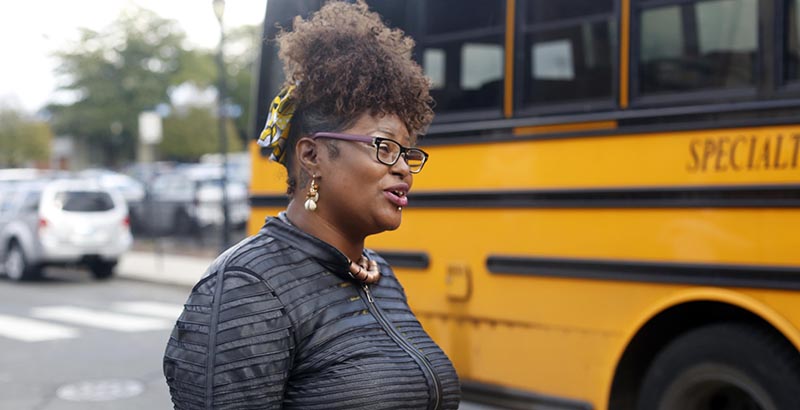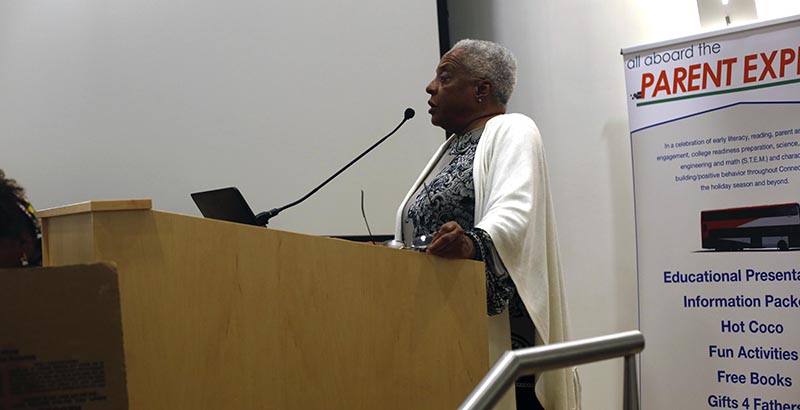Cardona’s Role in Connecticut’s Complex School Desegregation Efforts Becomes Focus: Will He Give Integration a National Platform as Ed Secretary?

While announcing a landmark settlement in one of the nation’s most significant and fraught school desegregation lawsuits, Miguel Cardona kept his remarks optimistic but brief. Just five months after being appointed Connecticut’s top education chief, he welcomed a major step forward in a three-decade-long battle over persistent racial segregation in the state’s capital city, even if his own role was short-lived.
“Today we are eager and excited about moving forward and moving the conversation from litigation to education,” Cardona, who became President-elect Joe Biden’s surprise pick for U.S. education secretary last month, said during a press conference in Hartford a year ago this month.
He was referring to the case Sheff v. O’Neill, which began in 1989 and led to a 1996 state Supreme Court ruling that found Hartford children “suffer daily” from the “devastating effects” of stark racial isolation in the city’s public schools.
The case has been closely watched on a national level for years and Cardona’s involvement in it has prompted quick speculation about whether he will bring a new imperative to the Education Department on school desegregation. But the Hartford case — and Connecticut’s larger history of racial segregation in schools — is complex. Defining Cardona as an integration champion depends on who you talk to, particularly when it comes to those from his home state.
Cardona became Connecticut’s education commissioner “at a very late stage but a pretty important stage in the Sheff case,” said Philip Tegeler, executive director of the Washington-based Poverty and Race Research Action Council, and who was among the attorneys to file the 1989 lawsuit. Cardona’s willingness to speak at the press conference was laudable, he said, and was not emblematic of a bureaucratic posture that often dominates policymaking.
“That makes me very optimistic about this secretary and his understanding of the value of school integration,” Tegeler said.
Desegregation efforts in the Hartford region rely on a network of esteemed magnet schools and an “open choice” interdistrict enrollment scheme. They have been lauded by advocates as a way to entice integration between children from the city and those from the surrounding suburbs and were used as the model for a statewide integration initiative.
Some local education activists, however, say the Sheff remedy has failed to live up to its promises, others have questioned whether its voluntary integration scheme is the best approach to providing an equitable education to children in the state’s underfunded urban schools.
Among critics is Gwen Samuel, founder and president of the Connecticut Parents Union and the plaintiff in a lawsuit against Cardona and other state leaders to halt the statewide school desegregation effort. Samuel argues the undertaking wrongly relies on a “racial quota” in order to meet diversity goals, resulting in coveted seats being set aside for white students while students of color languish on a waiting list. Rather than desegregating schools, Samuel believes that policymakers should focus instead on improving the quality of campuses that primarily serve Black and Latino children.
“We did terrible with our desegregation efforts,” she said, noting that she agreed with the intent, but not the outcome. “How it rolled out discriminated against the very children that needed those high-quality magnet schools the most. As the U.S. secretary of education, I don’t want [Cardona] to even look at Connecticut’s desegregation efforts at all, because then he would force us to organize against him.”
Meanwhile, the lawyers representing Samuel, from the libertarian Pacific Legal Foundation, very much want the eyes of Washington, D.C. on Connecticut’s integration track record. Their intent is that the Supreme Court will take up the case and use it as a way to set a national precedent barring schools from considering race in any way in admissions decisions.
‘Restore the soul of America’
While the topic of racial isolation in schools often conjures imagery of the segregationist South, Cardona’s home state has among the most racially divided classrooms in the country. Yet the state’s persistent divisions are a microcosm of the country at large: More than 65 years after the Supreme Court ruled in the landmark case Brown v. Board of Education that laws creating separate schools for Black and white children were unconstitutional, America’s classrooms remain as divided by race as they were decades ago.
Though several Supreme Court opinions have chipped away at the Brown decision’s promise over the last few decades, the issue of school desegregation has enjoyed newfound interest in recent years — particularly after George Floyd’s death at the hands of a Minneapolis police officer fueled nationwide unrest over racial inequities. Last summer, Black Lives Matter yard signs popped up in Connecticut’s whitest and poshest cul de sacs, leaving activists hopeful that the reckoning could forge a new path for systemic changes.
Yet, even with the 2020 court settlement, in which Cardona and other state lawmakers committed to a major new investment in integration, a heated debate over desegregation in the Hartford region — and its national implications — is far from over.
With Cardona tapped to replace Education Secretary Betsy DeVos, his public remarks on the major civil rights case, albeit limited, suggest to some the possibility of a major shift in the U.S. Education Department’s tenor on racial integration in America’s persistently segregated classrooms. School integration advocates have urged Cardona to leverage his experience with the Connecticut case as he joins Biden’s campaign promise to “restore the soul of America.”
After attorney Martha Stone met with Cardona in January 2020 to discuss the state’s commitment to ending racial isolation in Hartford’s schools, she left with optimism.
Other government leaders have been far less amenable, she told The 74. In the three decades since Stone filed the Sheff desegregation case in state court, Connecticut has had nine education commissioners and the Harford district has had 17 superintendents during her fight to secure quality schools for children of color and those from low-income households.
During those years, policymakers’ commitment to desegregation has ebbed and flowed. Former Gov. Dannel Malloy, for example, fought unsuccessfully to dilute the state’s desegregation obligations. But under current Gov. Ned Lamont, she said the state was more willing to confront segregation. Under the 2020 settlement agreement, the state agreed to add additional seats to its high-demand magnet schools and spend more than $2 million to facilitate integration, including on recruiting efforts to bolster interest among students in the region’s affluent, predominantly white suburbs.
Critical for Hartford students was a long-term commitment to fulfilling Sheff’s promise by providing enrollment to an integrated school to any student interested in attending one, Stone said.
“That was a significant piece to this latest settlement and it’s the first time the state had actually agreed to meet demand,” she said. “It doesn’t mean that every student would get an integrated setting — but every student that wanted that would have the opportunity.”
School integration advocates hope that Cardona will take that success nationally. Among those watching optimistically is Richard Kahlenberg, director of K-12 equity and a senior fellow at The Century Foundation, a progressive think tank in Washington. In a recent report, the group found that some 900 school districts and charter schools nationally maintain policies that seek to promote racial or socioeconomic integration. Among them is Minneapolis Public Schools, which approved new attendance boundaries to promote integration just weeks before Floyd’s death.
Cardona’s role in the Sheff case should give him “enhanced awareness of school integration as an issue,” and, in particular, “how integration can be done well,” Kahlenberg said in an email. “To my mind, that’s a big plus given the critical role that school diversity plays in fostering social mobility and social cohesion.”
Gina Chirichigno, director of the National Coalition on School Diversity, is also optimistic about Cardona’s federal appointment. After Biden’s presidential victory, her group released a list of 10 changes the Biden administration could make in its first 100 days to prioritize school integration. Number one on the list was nominating an education secretary with a “demonstrated commitment to school integration and racial justice.”
Though Cardona’s short tenure as Connecticut’s education commissioner doesn’t provide “a huge amount of evidence in terms or real policies and implementation” related to integration, she said her group has met with the Biden transition team and went away feeling hopeful. The transition team didn’t respond to requests for comment on this article.

The resistance
Despite optimism circling Cardona’s appointment, school integration efforts remain deeply divisive — even on the Democratic campaign trail. During a presidential debate in 2019, Biden found himself defending his opposition to busing as a desegregation strategy in the 1970s when Vice President-elect Kamala Harris, then a Democratic primary rival, put him on blast for finding common ground with segregationist senators.
And while Hartford’s progress on integration has been lauded nationally, the issue is more contentious on the local level. This became apparent in 2017, when a Hartford Courant investigation found that Black and Latino students were denied magnet school seats in an attempt to maintain racial diversity at the campuses. In some cases, magnet schools that failed to attract enough white or Asian students left seats unfilled rather than enrolling additional Black or Latino students.
The story led to the Pacific Legal lawsuit, which alleged that magnet school enrollment relied on an unconstitutional “racial quota” that limited the number of Black and Latino students to 75 percent of the schools’ student bodies. In order to promote diversity, the suit alleged, the magnet schools implemented a lottery system that gave preference to white and Asian students.
In an apparent effort to blunt the court challenge, the 2020 Sheff settlement made changes to an overwhelmed lottery system that picks children for sought-after seats in the region’s specialized magnet schools while fulfilling its goal of creating racially diverse settings. Rather than focusing on race, the lottery system considers students’ economic status, such as family income and educational attainment.
The change prompted the Pacific Legal attorneys to drop their lawsuit aimed at the Hartford-area integration-focused magnet schools, but their challenge to the statewide desegregation effort that followed Sheff’s lead goes on. In bolstering its case, the suit alleges a New Haven magnet school was forced to close in 2018 because its Black and Latino enrollment, at 91 percent, put it under threat of state sanction. The school failed to meet racial integration goals by not having white and Asian students account for at least 25 percent of enrollment.
Samuel, the plaintiff and Connecticut Parents Union president, urged Cardona against touting Hartford as a desegregation success story. As a resident of Meriden, Cardona’s hometown, Samuel has known Biden’s education secretary nominee for years, characterizing him as a “family man” who “looks for paths of least resistance.”
But this isn’t likely a controversy he’ll be able to avoid.
“You’re not going to tell children that the only way they can learn is by sitting in proximity of white children,” she said. Rather than focusing on race, Cardona and other policymakers should prioritize resources, she said, though integration advocates have argued that ending racial isolation could allow money and social clout to flow into all schools. As far as Samuel is concerned, Cardona hasn’t done enough to weigh in on the topic.
“I like Miguel as a person,” she said, “but his silence on desegregation is a problem.”
The legal threat
Oliver Dunford, a Pacific Legal Foundation attorney, acknowledged that considering socioeconomic factors to foster school diversity is constitutionally sound, so long as it is more than a “proxy to disguise when it’s in fact a racial quota.” But he made no secret of his desire to pursue a more restrictive school desegregation ruling from the U.S. Supreme Court.
In its most recent school segregation opinion, in 2007’s Parents Involved in Community Schools v. Seattle School District No. 1, the high court struck down assignment plans that considered the race of individual students when creating integrated campuses. But the justices also maintained that avoiding racial isolation in schools is a compelling state interest and can be tackled through means that include drawing student assignment boundaries in a way that decouple campus demographics from the composition of racially segregated neighborhoods.
“Race may be one component of that diversity, but other demographic factors, plus special talents and needs, should also be considered,” then-Justice Anthony Kennedy wrote in a lengthy concurring opinion.
In response to that decision, the Obama administration released guidance noting that schools could take into account race as one factor when assigning students to campuses. The Trump administration rescinded the guidance in 2018, arguing that the Obama-era statements “prematurely decide, or appear to decide, whether particular actions violate the Constitution or federal law.” Re-implementing guidance similar to Obama’s could be a top priority for the Biden administration, integration advocates said.
Now, Pacific Legal hopes to secure a Supreme Court opinion that prohibits race-conscious admissions decisions outright, using Connecticut as one of several efforts to reach that goal.
“If we win, then obviously it would set a precedent,” said Dunford, who has never interacted with Cardona directly while litigating Connecticut’s desegregation efforts. “If we got a Supreme Court ruling, then obviously it would be binding across the entire country. Ultimately, we take cases with the hopes of trying to set precedent, so we certainly would like it if this case could end up eliminating racial quotas in education.”

The housing connection
In his brief remarks last year after the state reached its major court settlement with the Sheff plaintiffs, Cardona stepped up to the podium and quickly turned the conversation toward a dynamic for which he had limited — if any — control.
“While the state’s department of education is [focused] on educational policy, we must acknowledge that racial imbalance exists to a large degree outside the schoolhouse as well,” he said. “We are committed to being a part of that broader conversation.”
He made similar remarks last month when Biden announced him as the education secretary pick, noting that “for too many students, your zip code and your skin color remain the best predictor of the opportunities you’ll have in your lifetime.”
Those comments fall in line with some school integration advocates who believe the best path forward to securing equitable schools is by tackling neighborhood segregation. Such efforts seek to limit the effects of a 1974 U.S. Supreme Court ruling that allows communities to draw up school district boundaries as tools of segregation. In the case, Milliken v. Bradley, the justices found that communities weren’t required to address segregation across school district lines.
Yet in Connecticut and nationwide, housing segregation perpetuated in part by exclusionary zoning laws has been a reliable engine for school segregation. Anecdotes suggest that Cardona has long grappled with the effects of neighborhood composition on school quality. While assistant superintendent in Meriden, the largely working-class city where he grew up, he led new teachers on tours through its neighborhoods to highlight his community’s stark economic inequities.
Locally, lawmakers are discussing rules that would tie nearly a half-billion dollars in state school construction grants to towns’ willingness to offer more affordable housing. Nationally, Tegeler, of the Poverty and Race Research Action Council, said Cardona could embrace greater collaboration between the Departments of Education, Transportation and Housing and Urban Development similar to efforts in the waning days of the Obama administration. Through the agency collaboration in 2016, the administration promoted community efforts that sought to diversify both schools and neighborhoods. Biden’s pick to lead HUD, Marcia Fudge, gives Tegeler optimism that such a collaboration could be in the making. As a Democratic congresswoman from Ohio, Fudge has championed legislation to create a federal grant program focused on school integration.
“Unexpectedly, to have a school integration expert at the Department of Housing and Urban Development is a great development,” he said.
But Jamilah Prince-Stewart, executive director of the religious coalition FaithActs for Education, argues that lawmakers locally and elsewhere should prioritize what she said was central to the promise of integration: Access to equitable education funding. Her comments highlight how the issue of integration could get lost in the sea of priorities — particularly as the Biden administration seeks to help schools recover from the pandemic.
“We care about diversity, we care about integration, but most importantly we care about equal and equitable access to resources,” she said, noting that affluent Connecticut residents have responded with “very racist, very classist, very problematic reactions” to school regionalization efforts that she said could decouple the effects of neighborhood segregation from classroom demographics. To solve the issue, she’s calling on state lawmakers — and those who embraced the Black Lives Matter movement last summer — to take action.
“You can’t be for Black lives and want what’s best for Black students while also saying ‘Hands off my schools,’” she said. “Now is really the time to put your money where your mouth is and to actually turn that rhetoric into practice and to support what is needed for Black and brown students.”
Under the threat of court challenges and a public perception of integration efforts that can be viewed as mixed at best, Kahlenberg of the Century Foundation said that Biden and Cardona should broach the topic through school choice and incentives — rather than a compulsory busing scheme that became a flashpoint during the Democratic debate. He agreed with Kamala Harris that integration is “a moral imperative and opens up tremendous opportunities for children,” but also agreed with Biden that compulsory busing “didn’t always achieve the intended results.”
But if schools nationwide look to Hartford as an example, they’ll be able to promote diversity in schools in a way that’s “legally bulletproof against right-wing attacks.”
“There is a third path available, and Connecticut has led the way,” he said. “Cardona may be uniquely positioned to advance Joe Biden’s signature goal of healing the soul of the country and uniting the nation.”
Get stories like these delivered straight to your inbox. Sign up for The 74 Newsletter

;)
